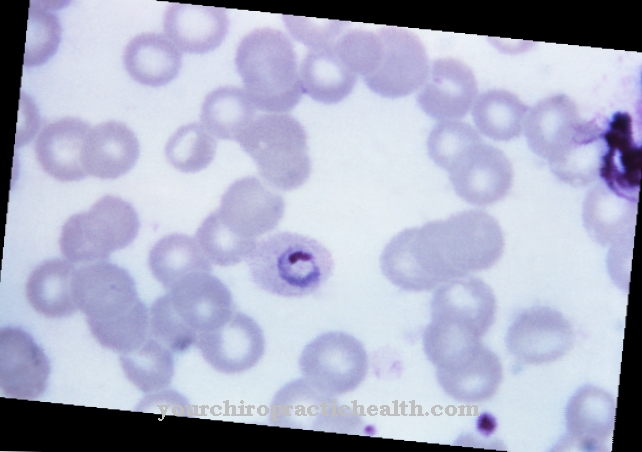The Mycoplasma genitalium belongs to the genus of mycoplasma. The mycoplasma was first isolated from sick cattle in 1898. With the Mycoplasma pneumoniae a form pathogenic for humans could be detected for the first time in 1962. Mycoplasma genitalium was discovered in 1981 and assigned to the genus Mycoplasma as a new species in 1983. Complete gene sequencing was published in 1995.
What is mycoplasma genitalium?
The bacterial species Mykoplasma genitalium belongs to the genus of mycoplasma and to the superordinate class of mollicutes. Bacterial species of the class of the Mollicutes do not have a cell wall. The designation Mollicutes means soft skin or soft skin (Molli = soft, plump; Cutis = skin) and indicates this.
The missing cell wall of the mollicutes in general and of the mycoplasma in particular allows a pleomorphic, i.e. diverse form. The bacteria appear both vesicular and thread-like and can change shape as required. The thread-like shape of the mycoplasma is very reminiscent of a fungus, which is expressed in the name mycoplasma. Translated, Mycoplasma (Myko = mushroom and Plasma = shape) means something like "mushroom-shaped".
In addition to the pleomorphic properties, the lack of a cell wall also causes pronounced susceptibility to various environmental influences. Even slight osmotic fluctuations in the surrounding medium can kill the germs.
On the other hand, due to the lack of a cell wall, mycoplasmas also show a natural resistance to antibiotics that adhere to the cell wall. Conventional antibiotics such as penicillins therefore have no effect.
The mycoplasmas are very small and, at 200-300 nanometers, are among the smallest bacterial species in the world. Because of their small size, they often play a role as laboratory contaminants. Since most sterile filters produced in series do not have a nominal pore size of 220 nanometers, an effective filtration of mycoplasma cannot be guaranteed. The mycoplasma genome is one of the smallest prokaryotic genomes in the world.
With 580-1,380 kbp, mycoplasmas belong to the genetically smallest germs capable of auto-replication, alongside the nanoarchaeum equitans (~ 500 kbp) and the endosymbiont Carsonella ruddii (around 160 kbp). Another abnormality is cholesterol, which is contained in the cell membrane of the mycoplasma and can otherwise only be found in eukaryotic cells.
Exact RNA studies show that the genus of the Mollicutes cannot be counted as the basis of the bacterial family tree, but rather emerged through degenerative evolution. A descent from germs of the Lactobacillus group and a subsequent loss of large parts of genetic information through degenerative evolution is very likely and makes the class of the Mollicutes to representatives of the organisms with the smallest known genome.
The small genome of the mycoplasma is ideal for research into synthesis, so it is not surprising that the research group led by Craig Venter synthesized the germ Mycoplasma genitalium in 2008. The replica is called Mycoplasma genitalium JCVI-1.0 and is considered the first completely synthetically produced bacterium.
Occurrence, Distribution & Properties
Mycoplasmas have a parasitic way of life and are dependent on host cells. They can parasitize both extracellularly on the host cell and intracellularly. Mycoplasmas are dependent on essential metabolic components such as amino and nucleic acids from the host cell.
There is the ability to shrink the genome as needed, which is beneficial to an undemanding parasitic way of life. The mycoplasma genitalium settles in the urethra and lives here preferentially on the epithelial cells.
Illnesses & ailments
Mycoplasmas are responsible for numerous diseases due to their parasitic way of life. Along with Chlamydia trachomatis, mycoplasma genitalium is one of the most common pathogens for non-gonococcal urethritis. Non-gonococcal urethritis refers to inflammation of the urethra that is not triggered by the gonococci that are usually responsible.
The urethritis usually runs with typical symptoms such as intense burning sensation when urinating and mucous-purulent discharge. As a result, women may have profuse bleeding after sexual intercourse.
It can also lead to serious complications in women. The significantly shorter urethra can cause severe secondary inflammation. Inflammatory diseases such as cervicitis (inflammation of the cervix), endometritis, salpingitis and other pelvic inflammatory diseases can occur.
A correlation with other complaints and diseases such as infertility or ovarian cancer has been statistically proven, but has not yet been proven causally.
Reduced development of the prostate has been observed in men with a past infection and is up for discussion.
A higher intensity of HIV infection by Mycoplasma genitalium is also discussed. Furthermore, it is questionable whether the mycoplasma genitalium has to be defined as a sexually transmitted pathogen.
Urethritis, also popularly known as gonorrhea, is a commonly transmitted infectious disease. Treatment with antibiotics is possible. However, since several pathogens can trigger the symptoms, identification of the antigen with all resistances is essential for successful antibiotic therapy.
For Mycoplasma genitalium, as for most germs of the Mollicutes class, an antibiotic of the macrolide class, especially azithromycin, is recommended.The macrolides do not attack the pathogen on the cell surface like penicillin, but prevent further replication by slowing down the pathogen's protein synthesis.
A hasty administration of antibiotics, especially penicillin, can lead to increased persistence of the pathogen, especially in the case of germs of the Mollicutes class.
















.jpg)



.jpg)

.jpg)




